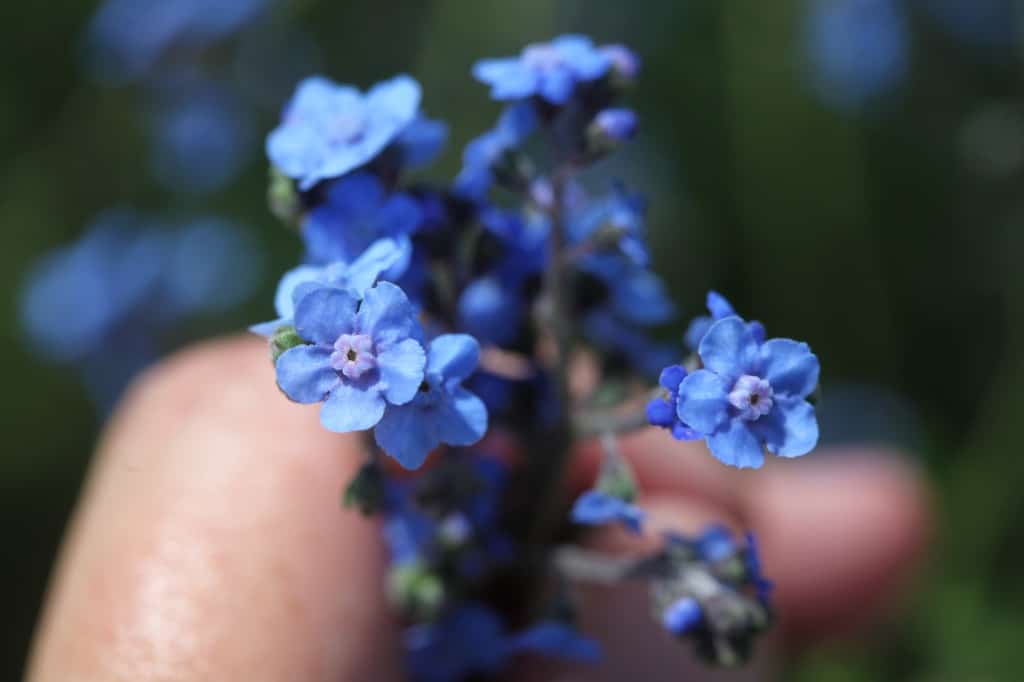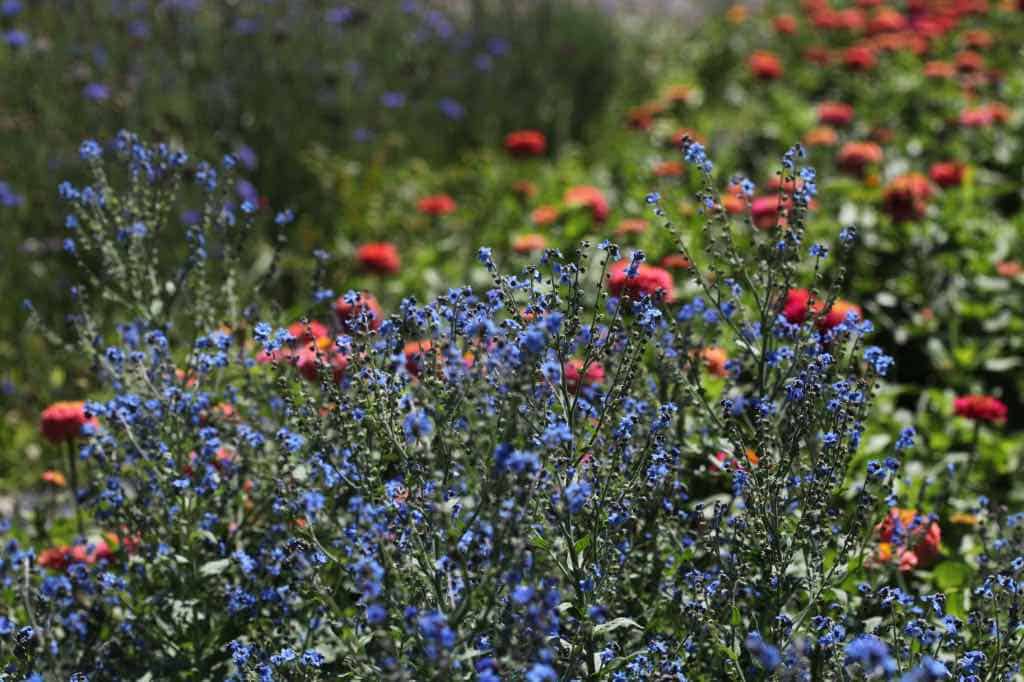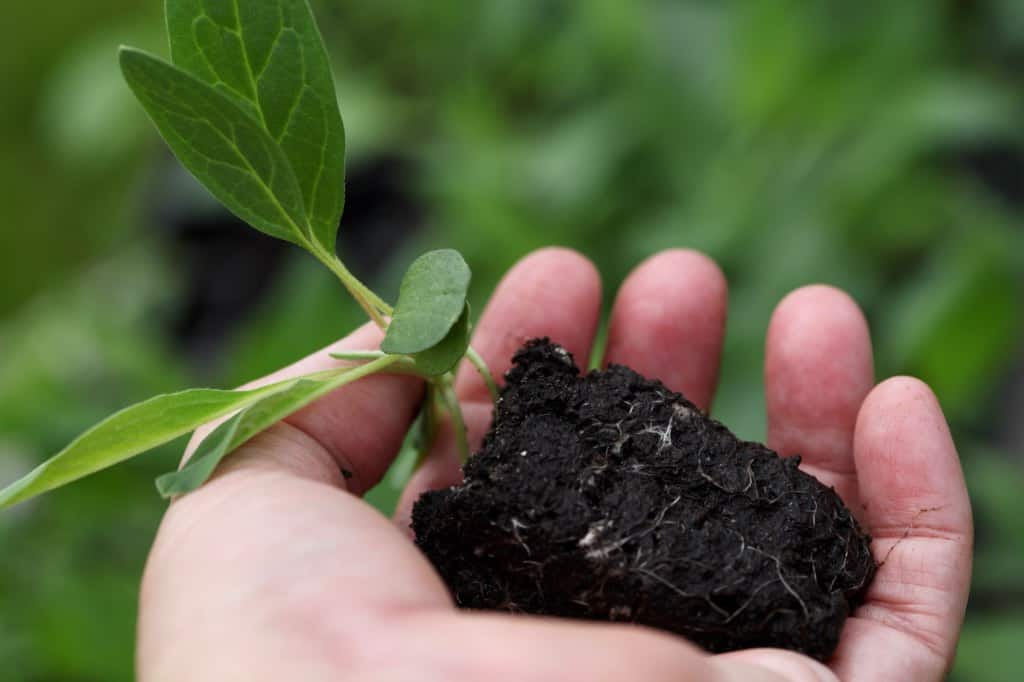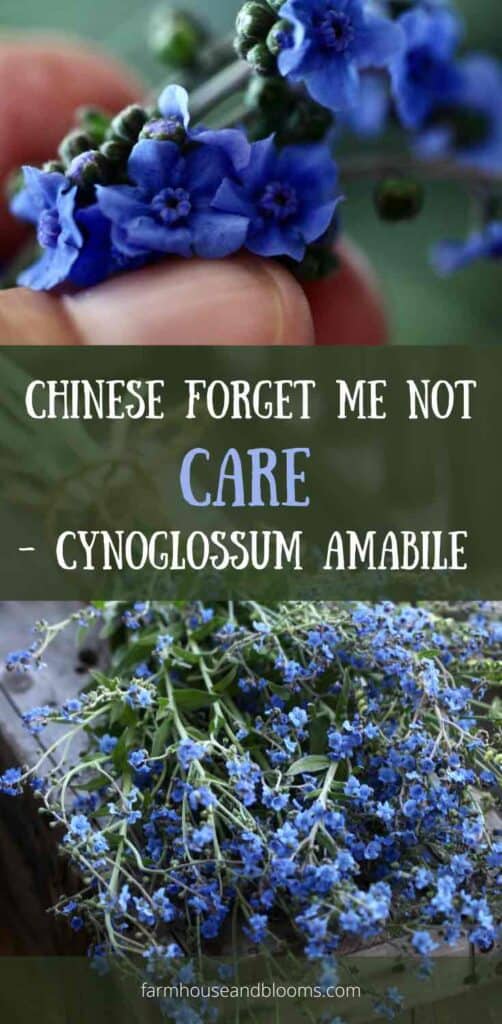Chinese forget me nots are easy to grow hardy annual flowers with tiny blue blossoms. The flowers are lovely in wildflower arrangements, adding a special touch of bright sky blue. Learn all about Chinese forget me not care, and get your blooms in tip top shape for the season.

I love to grow Chinese forget me nots during gardening season, as they shine in the garden all summer long. The tiny blue flowers catch the sunlight, making them glow in the garden, at just the right angle.
They are great for the pollinators, and the bees absolutely love them.
These plants are hardy annual flowering plants, and will need to be planted every year.
They will often return however as volunteer plants, and can spread a distance away, due to their unique method of travel.
The mature seeds are easily able to latch onto animals or passers by, lending to the spread of the plant for the following season.
In our zone 5b garden, we do not get many Chinese forget me not volunteers, although this is something to consider in warmer growing zones.

What Are Chinese Forget Me Nots?
Chinese forget me nots are a species of flowering plants from the Family Boraginaceae, and the Genus Cynoglossum.
The species name for this plant is Cynoglossum Amabile.
Common names for the plant include Chinese forget me not as well as Chinese hound’s tongue.
The Chinese forget me not is related to the more commonly grown woodland forget me not that many are familiar with. The woodland forget me not, or Myosotis sylvatica, also belongs to the family Boraginaceae. Myosotis sylvatica however, belongs to the genus Myosotis, and is a biennial flowering plant.

Chinese forget me nots are hardy annual plants in colder climates, and a perennial herb in warmer climates.
The plants are very easy to grow, even for a beginner gardener, and will flower in the year that they are planted from seed.
Although the plants readily produce volunteer seedlings, they are not yet considered to be an invasive species, according to the Invasive Species Compendium data sheet on the Chinese forget-me-not.
Rather, they are considered to be weed to some, having escaped from the garden.

Now let's have a closer look at the plant.
The Plant
Chinese forget me not is a mounding plant, and sends out stems from the base of the plant.
The stems are sent out in succession, so that not all stems are flowering at the same time.
This contributes to the longevity of the blooming period in the garden.
The stems will also have flowers at various stages along one stem, and later on in the season you are likely to find flowers, buds, and seeds all on the same stem.
Chinese forget me nots are taller than their woodland cousins, growing in height in ideal locations to 20 inches or more. This longer length makes them ideal as a cut flower.
Our plants growing in clay soil at the farm often grow a bit taller than 2 feet in height.

The Flowers
The tiny flowers on Chinese forget me nots are very similar to the woodland species.
The blooms are quite small, at approximately 1 cm in diameter. Each tiny blue flower is five petalled, and there are many flowers on each stem.
The flowers most often come in shades of blue, pink or lavender. Blue seems to be a popular color.
The bloom time for Chinese forget me nots is from late spring to early summer, and into late summer and fall.

The Stems
Stems of Chinese forget me nots grow from the base of the plant.

These stems are strong and stiff, and grow to be about two feet in height.
The flowers are produced on multiple smaller stems, which grow and branch off at the top of the larger stalks.
These smaller stems or branches are lined with buds, which produce a multitude of blooms in succession throughout the growing season.

The Leaves
The green leaves of Chinese forget me nots are lancet shaped.
The common name for this plant, Hound's Tongue, is derived from the shape of the leaf, which is similar to the shape of the tongue of a hound.
Look closely and you will see that the leaves are attached directly to the main stem. They grow in a step like fashion, gradually become smaller towards the top of the plant.
They grow in an upwards direction from which they are affixed to the stem.
Small hairs growing on the leaf surface give them a soft texture which is noticed when touched.


The Seeds
The seeds of Chinese forget-me-nots are very interesting. The seed heads form visible seeds, which grow in clusters of four.
Each seed is covered with tiny burrs which make them very sticky on many surfaces.

The unique stickiness of the seeds allows them to be carried on unsuspecting travellers away from the original location.
Similar to burdock, the seeds will grip to many surfaces for a "tag along", hitching a ride and eventually dropping in another location.
They are easy to pull off, however they also stick exceptionally well.
All it takes is a walk past the plants, brushing up against them, to allow the seeds to attach and be transported.



Planting Chinese Forget Me Nots
Planting the seeds and care of the seedlings is the first part of Chinese forget me not care.
Chinese forget me nots can be planted indoors in late winter or early spring to give them a head start on the growing season. Likewise, they can be directly sown into the garden.

Planting Indoors
We tend to start most of our flower seeds indoors, to give them a head start on the gardening season. It also helps us to get ahead of the weed pressure, which is quite high in the fields.
Plant the seeds in cell trays or containers, in a good seed starting mix.
Cover the seeds with soil or vermiculite, as they require darkness for germination.
Water the tray, and keep the soilless mix moist until germination occurs.
Provide bottom heat from a heat mat, which can help with germination.
Germination will occur in one to two weeks, and sometimes earlier. Germination rate is dependent on the quality of the seed planted.
Remove from the heat mat and grow under grow lights.
Grow on under lights until the seedlings are ready to be transplanted out into the garden.
Make sure to harden off the seedlings before planting out.
Plant into the garden after the risk of frost has passed. Be aware of your frost dates for your usda plant hardiness zones.
Plant out after your own usda zones last frost date.

Direct Sowing Outdoors
Chinese forget me not seeds can also be direct sown into the garden, either in fall or early spring.
Direct sow into a prepared bed, and cover the seeds with a fine covering of soil.
The seeds are hardy, and will still germinate if exposed to frost.
In fact, cold exposure can help with germination by naturally stratifying the seeds.
When the time is just right for your growing zone, the seeds will germinate.
Winter Sowing
Chinese forget me not seeds are also great candidates for winter sowing in milk jugs, because they are hardy annuals.
Just make sure not to sow the seeds too close together, as the plants do not like root disruption at transplant time.
As well as with direct seeding, winter sown seeds will germinate at just the right time for your growing zone.

Planting The Seedlings Outdoors
Plant the seedlings into the garden once they have been hardened off.
Plant out in the cooler part of the day to avoid stress on the young seedlings.
Water in well after planting, as the seedlings have a tendency to wilt soon after transplanting.
If they do wilt, keep them well watered until they bounce back from the initial shock of transplanting.
The seedlings will tolerate low temperatures, and even a light freeze from a late spring frost after planting, due to their hardy nature.
Plant spacing should be approximately 9 to12 inches apart, to allow for good growth.
We grow our plants in landscape fabric with 9"spacing between the holes, and although the plants are touching as they grow, the spacing is appropriate.


Chinese Forget Me Not Care
Now let's have a look at some other aspects of Chinese forget me not care.
Growing Zone
These hardy annual plants grow in a wide range of habitats.
They are easily grown in zones 2 to 10.
Soil Requirements
Plant in well drained medium garden soil.
The plants tend to do better in a medium quality soil, rather than a rich fertile soil high in organic matter.
They also grow well in clay soil that drains well.

Water Requirements
Water in well on transplanting, and provide a moist soil with good drainage until the new seedlings become established.
Once established in the garden, water as needed. Generally the natural elements will take care of the watering requirements.
Light Requirements
Chinese forget me nots will grow in full sun to partial shade.
They do best in full sun for best flowering. However, consider giving some afternoon shade in warmer climates with hot direct sunlight.
Provide at least six hours or more of sunlight for best results.

Pruning
Once each stem on the plant begins to form seed, consider removing the stem. You can also pinch off the seed heads as they form.
It's much easier to remove the whole stem than pinching off individual seeds, which form on a continuous basis.
This will result in more energy diverted into flower production, rather than seed formation.
It will also help to prevent self seeding, which this plant has a tendency to do.

Conditioning The Flowers
The flowers of Chinese forget me nots have a tendency to wilt when cut.
This can be a bit frustrating, especially if you are planning to use them as cut flowers.
The secret to preventing wilting is to pick at the right time of day for harvesting, and to condition the flowers immediately after cutting, allowing for recovery time.
Make sure to cut the flowers at the right stage, just as they are beginning to open.
Cut in the cooler part of the day, and in the morning if possible. Use sharp clean shears or snips to cut the stems from the plant.
Cut the stems at the base of the plant, and remove the lower leaves.
Place the stems immediately into water, or a holding solution mixed with water.
Place the container of flowers in a cool and shaded location, for a couple of hours or longer.
Even if there has been some wilting, the stems should bounce back within a short while. Give them some time to condition and rehydrate, and to recover from the cutting.

Conclusion
Chinese forget me nots are great hardy annuals to grow in the home garden.
The plants are low maintenance, if you provide the right Chinese forget me not care.
Unlike the woodland forget me nots, often found in shady woodland gardens, this annual flower likes a sunny growing location.
The stiff stems and dainty little flowers make them great cut flowers, and are easy to use in floral design.

Pick at peak condition for best vase life.
The plant is known to self seed, so be diligent with pruning to prevent volunteer plants, unless of course you want them. The good news is that even the volunteers can be appreciated.
Although the plants tend to spread readily, at this point in time they are not considered invasive.
There are a number of different colors and varieties of Chinese forget me nots. We grow the firmament variety, which makes for an excellent cut flower.
If you are looking for a small blue flower to place in flower arrangements, this is certainly one to consider.
Whether grown for the garden or for use as cut flowers, this annual flower is likely to make an impression, with its bright blue flowers and long blooming season.

Have you ever wondered about Chinese forget me not care? Make sure to leave a comment below to share your experience.
Other Posts You May Like
PIN IT FOR LATER!










Leave a Reply